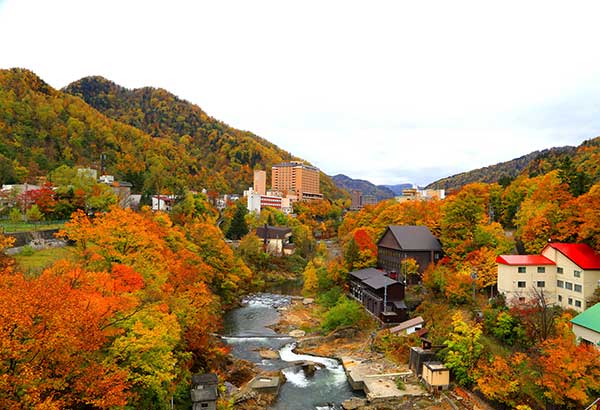Hokkaido: A destination for all seasons


Autumn in Hokkaido: The Jozankei hot springs, an hour from Sapporo, is a popular wellness attraction to ease stress and eliminate toxins from the body.
When Filipinos think of Hokkaido, they usually think of snow.
The northernmost of Japan’s four islands first hit the Pinoy consciousness, thanks to the town of Niseko, with its four ski resorts and incomparably fine powder, in which even non-skiing Filipinos could snowshoe, snowmobile, and otherwise frolic.
But, as I recently found out at the recent Visit Japan Travel and MICE Mart (VJTM), Hokkaido is a destination for all seasons. And fall — the time of changing leaves, apple-picking and brisk weather — is another great season for Filipinos to enjoy.
With a four-hour plane ride to Tokyo, and another short, 90-minute flight to Hokkaido, the island, whose name means “very big land,” according to our guide Sachiko, is so vast that VJTM arranged not just one but two familiarization trips for travel industry people and media — one touring the eastern part and the other focused on the more central area around Sapporo, the capital of Hokkaido.
As a newbie I chose to go with Sapporo and central Hokkaido. From Tokyo Haneda we took a Japan Airlines flight to Asahikawa, Hokkaido’s second largest city after Sapporo.
Late September is the beginning of autumn in Hokkaido, and the weather is cool during the day and nippy at night, as the leaves have started to turn to their fall oranges, reds and golds.
Asahikawa pig is a famous brand in Japan, and the area is also known for sake brewing and ramen. Replete with natural beauty like snow-capped mountains in winter, Asahikawa even opened a new international airport to attract more foreign tourists.
Japanese soul food: Ramen
Our first stop was Asahikawa Ramen Village. “Ramen is Japanese soul food,” Sachiko said, and you get a lot of soul at the ramen village, which houses eight restaurants, all serving their variations on ramen. Whichever you choose, be aware that Asahikawa ramen is different from the Hokkaido ramen you might be familiar with.
For one thing, Hokkaido’s harsh winters require that the broth be kept warm, so don’t be surprised if your soup arrives with a film of lard on top of it. Some blend seafood with pork bones to enrich their stock; others cook down pork with chicken. Then the broth is flavored with soy sauce (shoyu), salt (shio), or miso. Lastly, the noodles are wavy, with less water content so they have a firmer bite. (www.ramenmura.com)
Well-fortified, we headed to Asahiyama Zoo, another of Asahikawa’s top attractions. Although Japan has 89 zoos in total, Asahiyama is the most visited here in the north, since they have an excellent collection of rare animals. While the Hokkaido Animal House with its native brown bears and red foxes is unique, the Fierce Animal House is a must-see, with its Siberian tigers, lions and magnificent snow leopards. (www.city.asahikawa.hokkaido.jp/asahiyamazoo/)
We ended our first day on a mellow note, with a stroll through Ueno Farm, a former rice farm that has now been landscaped into the style of a romantic English flower garden. In bloom from May to mid-October, Ueno has many Instagram-worthy nooks and crannies ideal for selfie-ing. (www.uenofarm.net)
Accommodations are comfy at the Art Hotel Asahikawa, which, contrary to its name, doesn’t boast a lot of art on the walls. They do offer a great breakfast buffet on the top floor with panoramic views of the city, however. The delicious spread includes a separate kids’ buffet, bounty from Hokkaido’s dairy industry like cheese, butter and milk, and melon jelly made from the area’s star fruit, cantaloupe. (www.mystays.com/art-asahikawa)
Whisky, apples & glass
Hokkaido, which was sparsely populated and considered Japan’s “next frontier” before Sapporo became famous for hosting the 1972 Winter Olympics, now boasts a population of 5.5 million — 23,000 of them Ainu native to the area. With no typhoons or rainy season to speak of, just a six-month winter blessed with lots of snowfall, Hokkaido’s mountains attract many Australian skiers and high-end tourists from China.
Traveling south to Otaru, our bus stopped at the Sunagawa Highway Oasis, a haven for confectionery where you can buy all your Hokkaido pasalubong, from milk caramels to corn chocolate to melon jelly.
Next stop was the town of Yoichi, notable for its Nikka whisky distillery. One of Japan’s top distilleries, Nikka was founded by the “father of Japanese whisky,” Masataka Taketsuru. Legend has it that Masataka went to Scotland in 1918 to learn whisky making, an art Scotsmen held sacred and never shared with foreigners. However, Masataka persisted, studying chemistry and apprenticing at three distilleries to learn different whisky-making techniques. Along the way, he fell in love with a Scottish lady, married her and brought her back to Japan, at a time (the 1920s) when mixed marriage was rare in the Land of the Rising Sun.
Masataka established the Yamazaki distillery in Kyoto, now owned by Suntory, before opening Nikka in 1934. He chose Yoichi because its climatic conditions most closely resembled Scotland, with its clear water, brisk air and rich peat. Now, Nikka’s Single Malt Yoichi ranks among world’s top single-malt whiskies, winning numerous awards. After doing a tasting, I can say they also make an exceptional apple wine. (www.nikka.com/eng)
Lunch was at Nikka’s Restaurant Taru, where we sampled chan-chan-yaki, a fisherman’s dish of fresh Hokkaido seafood (salmon, scallops, snow crab) and vegetables grilled in a sweet miso sauce. They like things sugary in this land of caramel and soft-serve ice cream.
They also like their fresh fruits. Yoichi is also famed for its Tsugaru apples and Campbell grapes, so a stop at the Yamamoto Sightseeing Orchard is a must. There, with an all-you-can-eat package, you can pick organically grown fruit off the vine and eat it right then and there; you only pay for what you take home. In autumn, the orchard specializes in grapes, pears, prunes and apples, and all of them were large and super-sweet. (www.fruits-yamamoto.net/en)
We arrived close to dusk at Otaru, a port city known for its glassware (Kitaichi, Japan’s No.1 glass factory, is located here), music boxes and canal. Lined with quaint-looking lamps and buildings, Otaru Canal is made for cruising at sunset, while landlubbers can opt for a rickshaw ride down streets like Sakaimachi, the main drag lined with glass, music box and souvenir shops. Food-wise, sushi is the specialty, with over 100 sushi restaurants to choose from.
We stayed at the Grand Park Otaru, the Ocean View rooms of which are highly recommended (parkhotelgroup.com). Otaru is the ideal base for attractions like the Blue Cave and Asarigawa hot springs, 20 minutes away by car. In spring, the cherry blossoms are lush at Temiya Park, while summertime fireworks and festivals are common. Autumn boasts the turning of the leaves, while in winter you can take a romantic canal cruise or walk the Snow Light Path. Year-round, you can see a splendid night view of the city from the Mt. Tengu cable car.
Sapporo: land of beer, cookies & ski jumps
Sapporo, a half-hour drive from Otaru, is young in terms of age, established in 1857 with a population of a mere seven people! Now boasting a robust two million, today Hokkaido’s capital is known for its ramen, beer, and annual ice festival.
Kids and sweets lovers can get their sugar fix at Shiroi Koibito Park, a Japanese version of Willy Wonka’s chocolate factory with its Chocolate Lounge, Soft Ice Cream House, and Cookiecraft Studio. Hokkaido company Ishiya makes its famed Langue de Chat cookies filled with white chocolate there. After all, Shiroi Koibito literally means “white lover.” (www.shiroikoibitopark.jp/english/)
Those who’d rather taste Hokkaido crab can head to the Sapporo Central Wholesale Market, where you can find magnificent specimens of this seafood delicacy and sample it fresh at nearby restaurants. (www.jyogaiichiba.com/)
Sapporo’s Olympic history is perfectly preserved at the Okurayama Viewing Point, where the 90-meter ski jump used during the 1972 Winter Olympics is located. In fall it’s green with Astroturf but still spectacular, and you can ride a chairlift to the top of the hill to take in stunning views of Sapporo. Down below, the Olympic Museum has interesting memorabilia and sports-simulation games like ski jumping, speed skating and hockey.(okura.sapporo-dc.co.jp/index.html)
A stellar attraction an hour away from Sapporo is Jozankei, an onsen (hot spring) named after a monk, Miizumi Jozan, who discovered it 150 years ago. The whole area, in fact, has been recognized as one of the “100 Best Water Source Forests,” giving rise to three onsens with various benefits. Jozankei is often called “netsu no yu” or “water for heat”: the sodium in its water seals in heat and warms you up from inside, making you sweat and pass toxins from the body.
Before we tried the onsen, Jozankei served the best meal I had in Hokkaido — a five-course dinner that included fresh sushi, Hokkaido crab, and tender, flavorful Wagyu beef that the Japanese like to dip in raw egg — all washed down with Sapporo beer, of course. Feeling rowdy on our last night, the travel agents in our group started to hold beer-drinking contests with the Jozankei and Sapporo tourism officials. After I reached my quota I went back to my room, donned the yukata (robe) provided, and enjoyed the indoor onsen for as long as possible. Jozankei also has an outdoor onsen from which you can view the sunrise and surrounding scenery while soaking your stresses away. (http://jozankei.jp)
While looking at the night view with steam rising around me I mused that Hokkaido really is a destination for all seasons. Across the island there are attractions and festivals year-round to lure travelers of every age, and fall, with its beautiful leaves and cool weather, is a particularly great time to visit. Greet autumn in Hokkaido — it’s good to live it again.
* * *
For information, visit the Japan National Tourism Organization website (https://www.jnto.go.jp). For details on tour packages, call Wanderstruck Travel and Tours, Unit 2 No. 18 21st Ave Brgy. Tagumpay Cubao, at 422-0785 or 0917-854-3779; and Far Eastern Travel Agency, 2F De Leon Bldg, 1151 MH Del Pilar cor. Nuestra Sra. De Guia, Ermita, Manila, at 708-2797, 0917-332-4170, or email info@feta.com.ph/ vannie.gile@feta.com.ph.



















